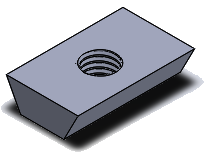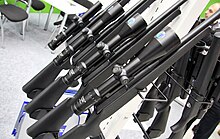|
Zeiss rail Zeiss inner rail,[1] generally simply referred to as Zeiss rail, is a ringless scope sight mounting system introduced by Zeiss in 1990 as an alternative to traditional ring mounts.[2] A patent was granted in 1992, and the patent expired in 2008.[3][1] The mounting system is now also offered on sights sold by other major manufacturers, such as Blaser,[4] Leica, Minox, Meopta, Nikon,[5] Noblex (formerly Docter[6]), Schmidt & Bender[7] and Steiner.[8] The system has so far seen most use on the European high-end market.[9] HistoryBefore the Zeiss rail, many European scope manufacturers used to offer a single type of standardized ringless mounting solution known as standard prism. This mounting solution was also known under names such as exterior rail, 70° prism rail or LM rail (Light Metal).[10] Compared to ring mounts, this type of mounting rail permitted mounting without putting compression on the internal mechanics of the scope. The system allowed the shooter to place the scope at their preferred height[citation needed] and correct eye relief (distance to the eye), as well as the opportunity to easily move the scope between different firearms. However, the standard prism had an aesthetic drawback in that the scope rail had to drilled on the side for attachment screws. In case the rifle scope was to be used on different guns, new holes often had to be drilled. A motivation for developing the Zeiss rail was to avoid such drilling.[citation needed] The Zeiss rail system was introduced in 1990 as an option on all Zeiss ZM/Z riflescopes, the top-of-the-line riflescope offered by Zeiss at that time.[citation needed] The system was later offered on the new top of line VM/V models. For these reasons, some sources have referred to the Zeiss rail system under names such as Zeiss ZM/VM rail or Zeiss M rail. Names such as Zeiss Integral rail, Zeiss 45° rail or simply Z rail have also been used.[9] Technical  Compared to the older prism rail, the Zeiss rail does not require any drilling, and therefore provides easier mounting to the user, as well as improved aesthetics.[citation needed] Compatible scopes have an internal dovetail rail where two or more 45-degree wedge nuts can be slid in. For example, EAW uses wedge nuts with M5 or M4 threads.[11] The scope mount is then attached using simple hand tools like a torx key or hex key to a torque between 4–5 N⋅m (3.0–3.7 lbf⋅ft).[12] Advantages
Disadvantages
Scope offerings The Zeiss rail system can be found on some models from scope manufacturers such as Docter, Leica, Minox, Meopta and Schmidt & Bender,[9] and sometimes only on high end models. Often the manufacturer will offer these models in two variations; one for traditional ring mounts, and another for the Zeiss rail mount. There are also examples of rifle scopes that have been sold exclusively for Zeiss rail mounts (i.e. no option for a ring mount version). These include the Zeiss Victory Diarange laser rangefinder scope[17] and the Zeiss Varipoint iC models.[18] In late 2017,[19] Blaser released their Infinity iC (illumination Control) line of scopes which also only uses the Zeiss rail system.[4] Mount offeringsAftermarket mounts compatible with the Zeiss rail system are offered by several well known manufacturers such as Blaser,[20] EAW,[9] Henneberger,[21] Innomount,[22] Kozap,[9] MAK,[23] Recknagel,[24] Rusan,[9] Uronen Precision,[25] Virtus,[26] and Ziegler.[27] Both two-piece or monobloc mounts are offered.[9] Compatible mounts are offered in different configurations, depending on the mounting opportunities on the firearm receiver. Examples include Picatinny, Weaver or different types of claw or swing (pivot) mounts. Scope height calculationsThe height placement of the scope on a rifle should be matched to the stock dimensions and personal preference. In general, a higher scope mount can give better recoil control, while a lower mount can give the firearm better balance. Especially the cheek rest and scope height together play an important role for comfortable shooting. Some cheek rests or scope mounts have adjustable height. The following section mentions relevant terminology. Mount construction heightThe construction height of a scope mount is an important factor contributing to how high the scope will sit on a rifle. "Construction height" typically refers to only the height contribution from the mount itself, and is typically provided by the mount manufacturer. Low Zeiss rail mounts typically have a construction height between 7–9 mm (0.28–0.35 in) for traditional bolt action hunting rifles, but can be up to 23 mm (0.91 in) for modern bolt and AR-style rifles. Scope body heightA Zeiss rail system typically adds height to the scope body, but also gives the possibility for a slimmer scope mount so that the total scope height can become comparable to a traditional ring mount. The added scope body height due to the rail piece on the scope itself contributes about 5.5 mm (0.22 in) to the total height. This can be treated like a constant term which can be added to adapt traditional scope height equations for the Zeiss rail system. Like with traditional ring mounts, the diameter of the scope tube itself also affects the distance from the bore to the crosshair. Mainly, a larger main tube will increase the total height by half the main tube difference (a 36 mm tube will thus typically sit 3 mm higher than a 30 mm tube, all else being equal). The height contribution from the scope body, that is from the bottom of the scope body to the center of the reticle, is typically provided by the scope manufacturer, along with the ~5.5 mm constant term due to the rail piece on the scope. Other considerationsThe distance from the center of bore to the top of the receiver interface is of interest for ballistics calculations, like when constructing a ballistic table. Competing standardsCompeting standards to the Zeiss rail include the Swarovski SR rail and Schmidt & Bender Convex rail. The three systems are not compatible. While the Zeiss rail has a stepless dovetail shaped mounting surface, the Swarovski SR rail has a finely toothed rail, and the S&B Convex has a smooth convex rail. Swarovski applied for patent on their SR rail system in 2002,[28][29][30] and introduced to the product to the market in late 2005.[31] The Swarovski SR rail is also used by Kahles, a Swarovski subsidiary.[32] The Convex rail has been offered by Schmidt & Bender since at least 2005,[33][34] and has also been marketed under the name LMC (Light Metal with Convex rail).[7] Contrary to the Zeiss and Swarovski rails, which ensure a levelled reticle, the S&B Convex rail instead allows the user to tilt the reticle up to 1° (60 moa; 17.5 mrad) to the left or right.[35] Since 2016, Schmidt & Bender has also offered the Zeiss rail system as an option on some of their hunting scope sights under the name LMZ (Light Metal with Z-rail).[7] References
External links |